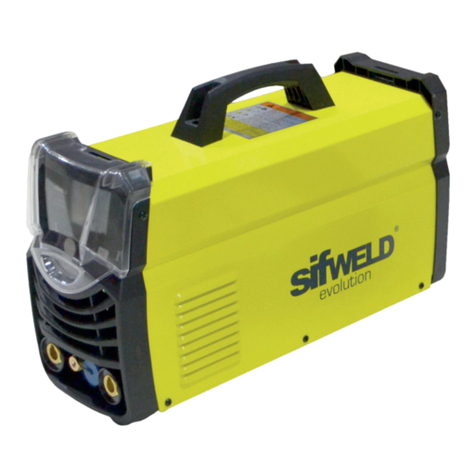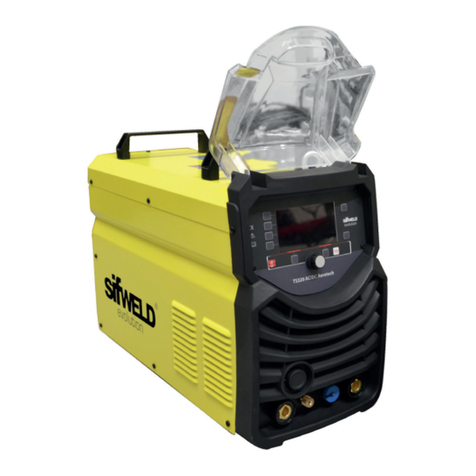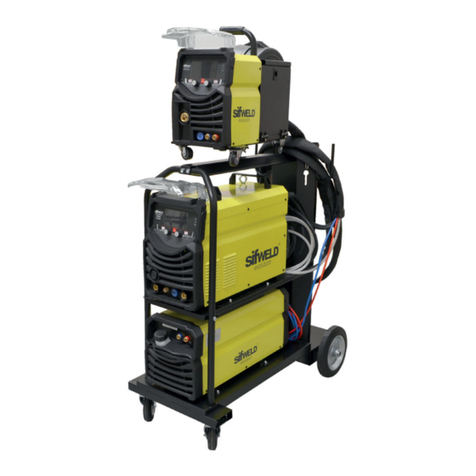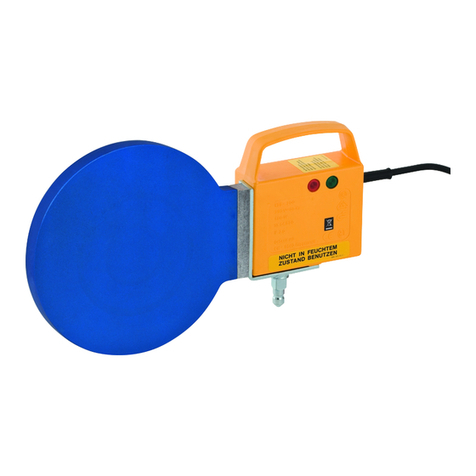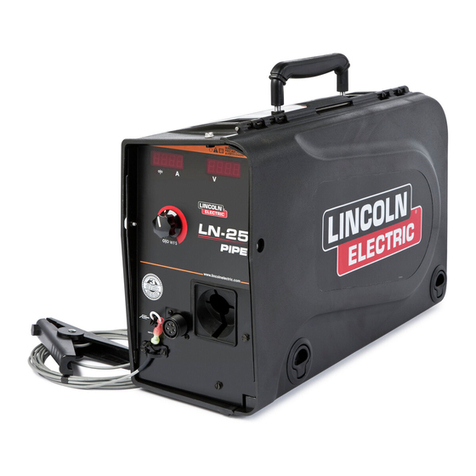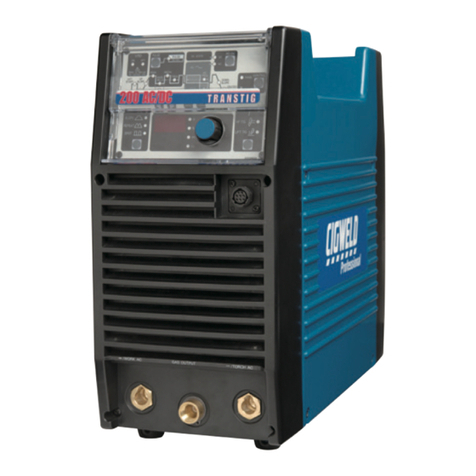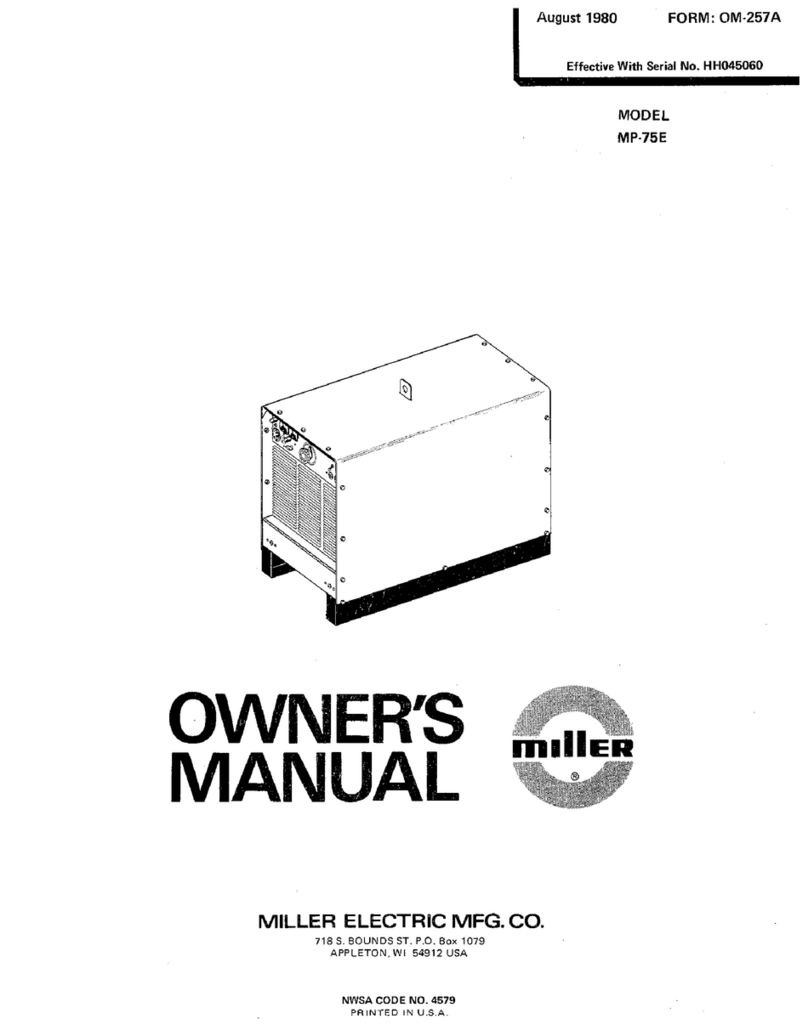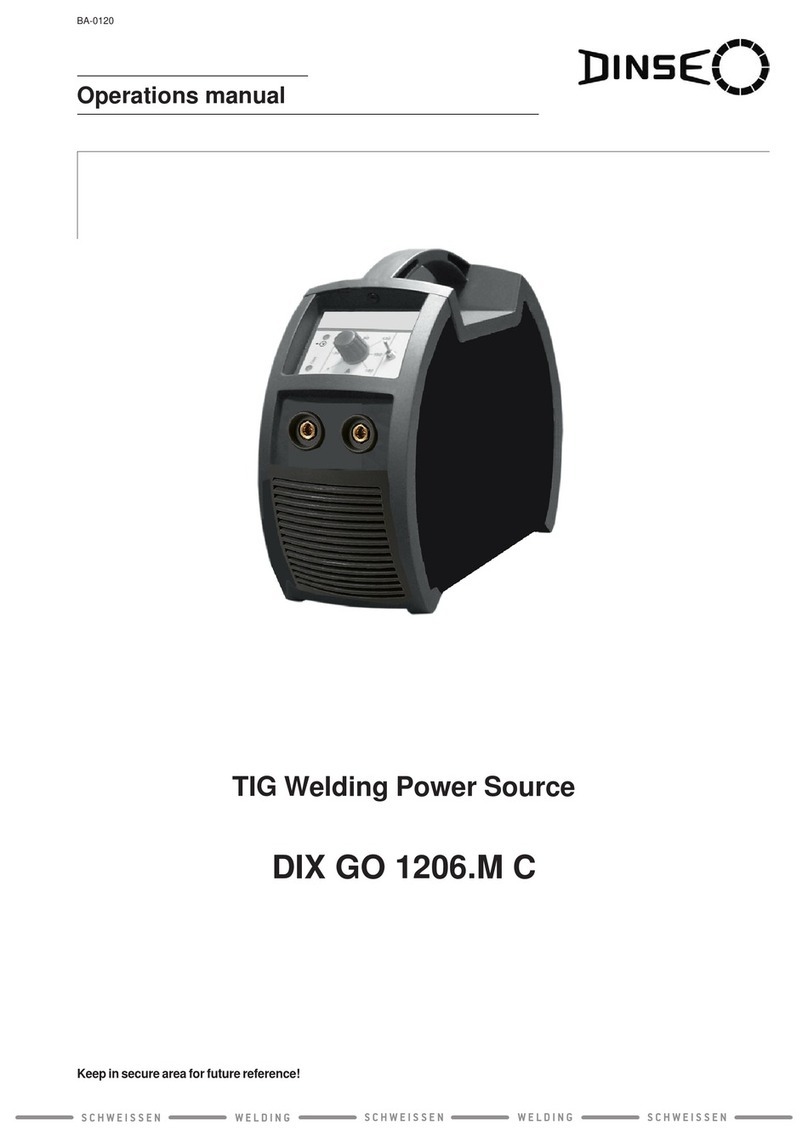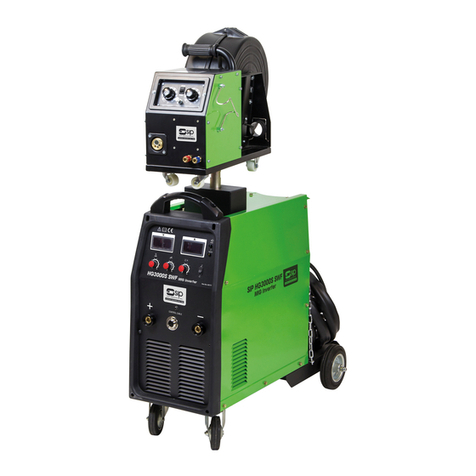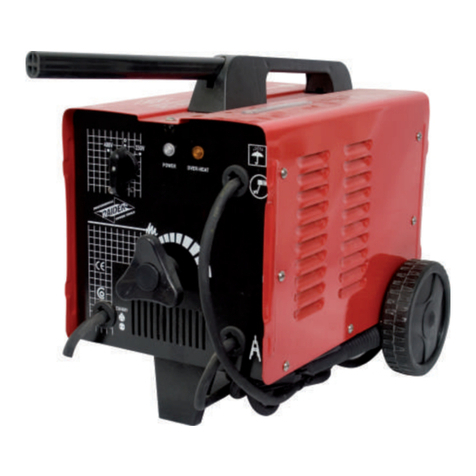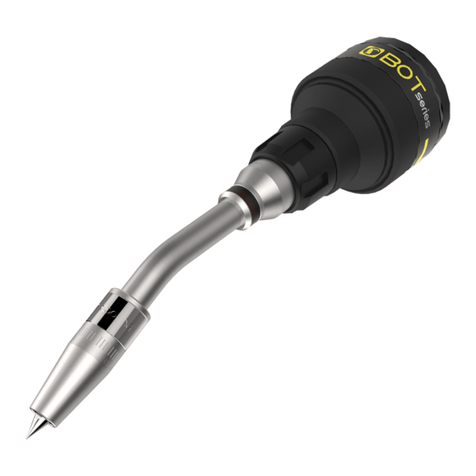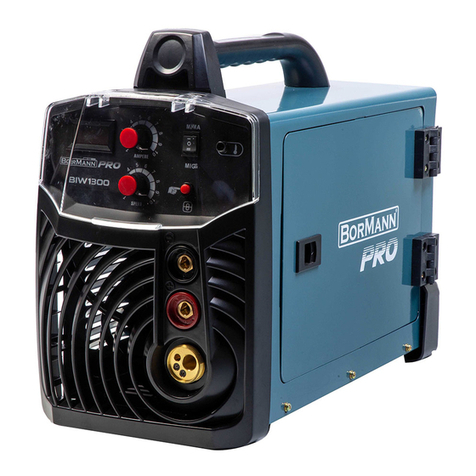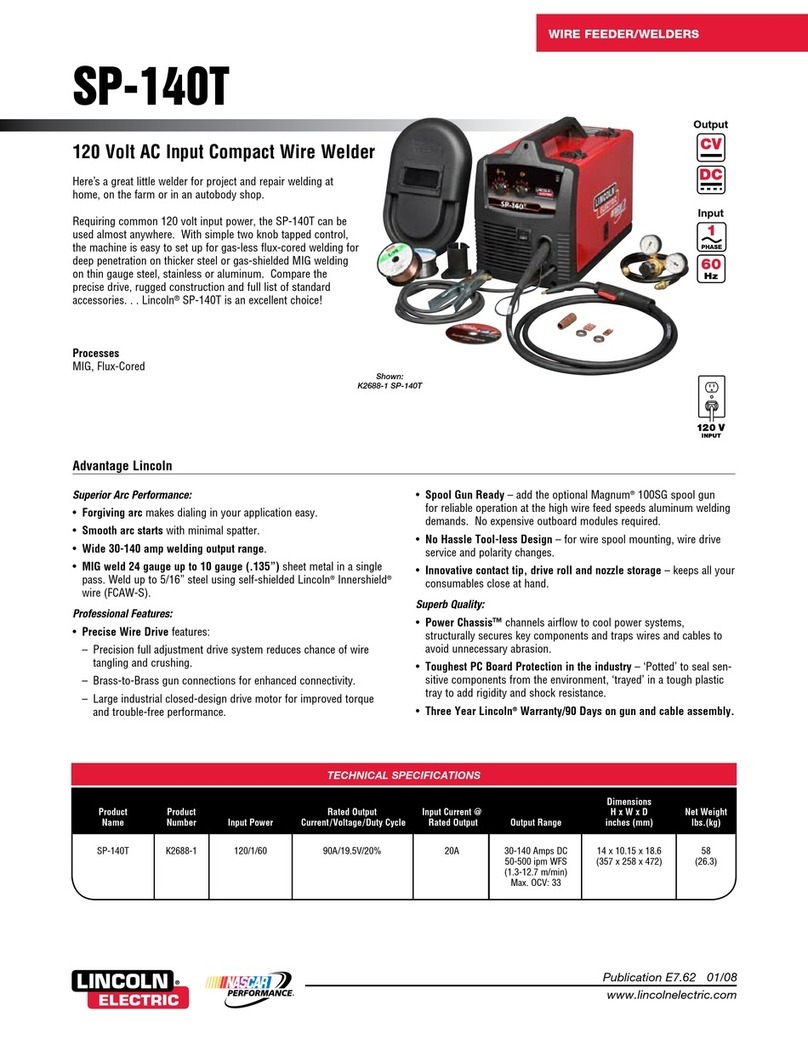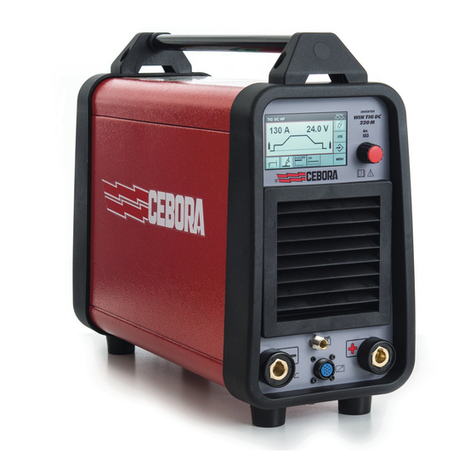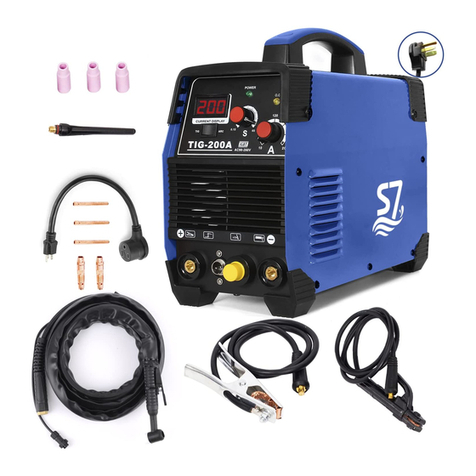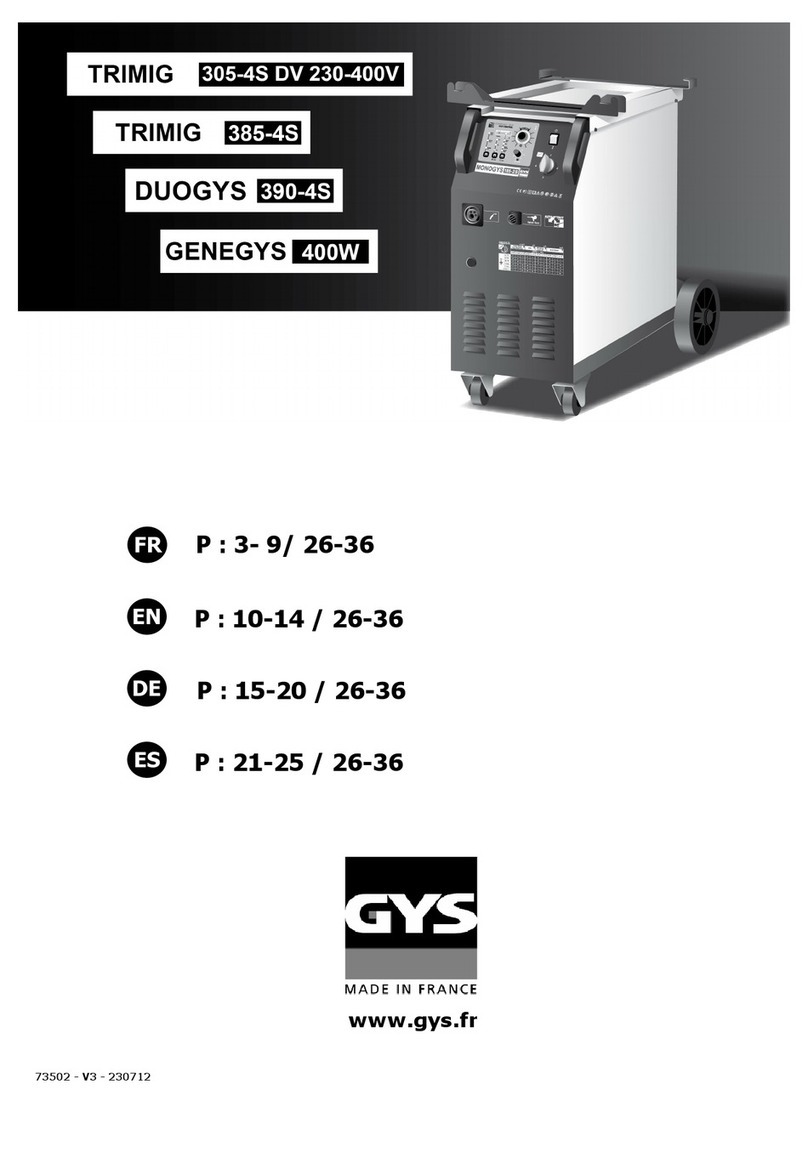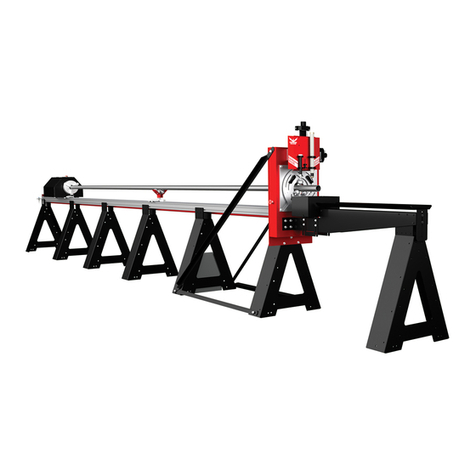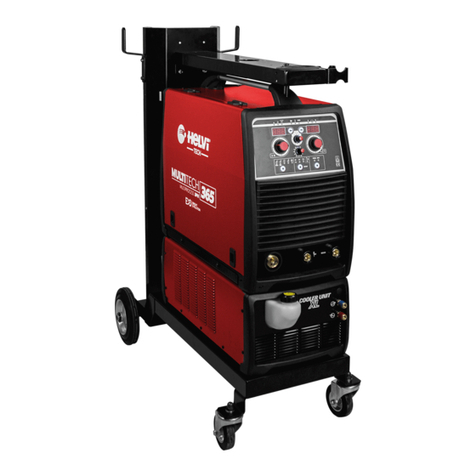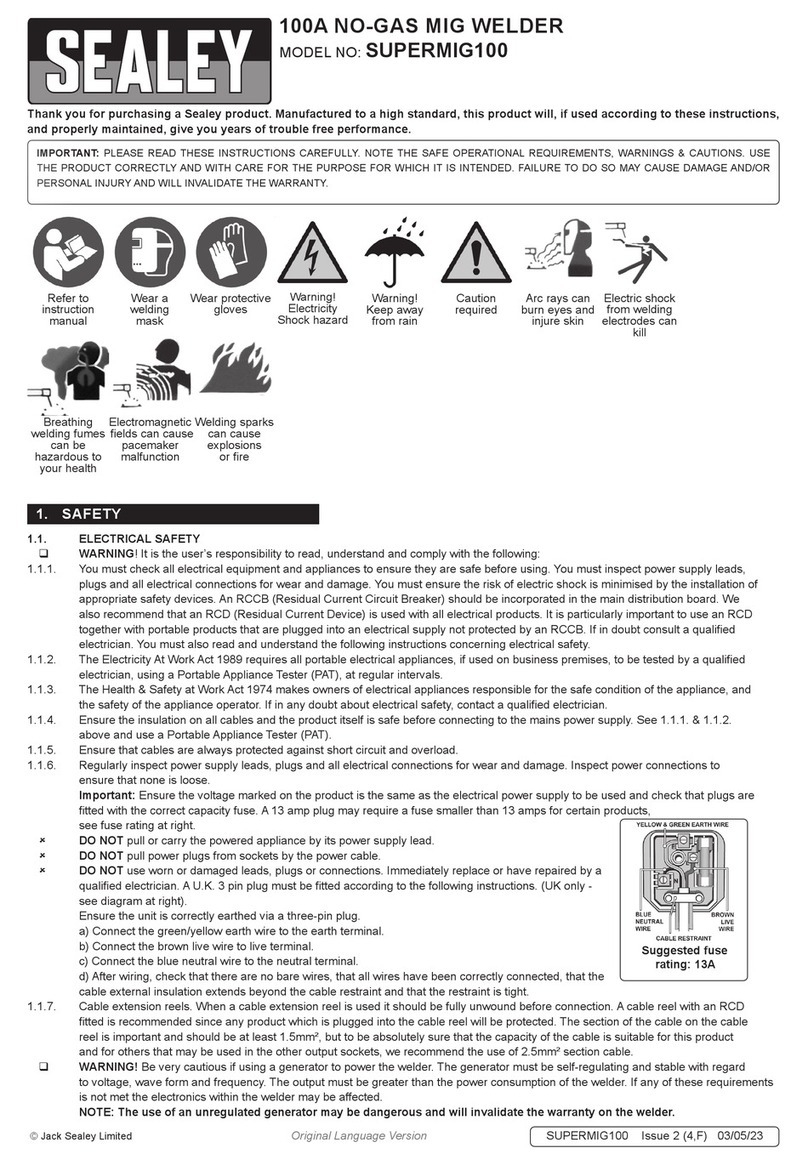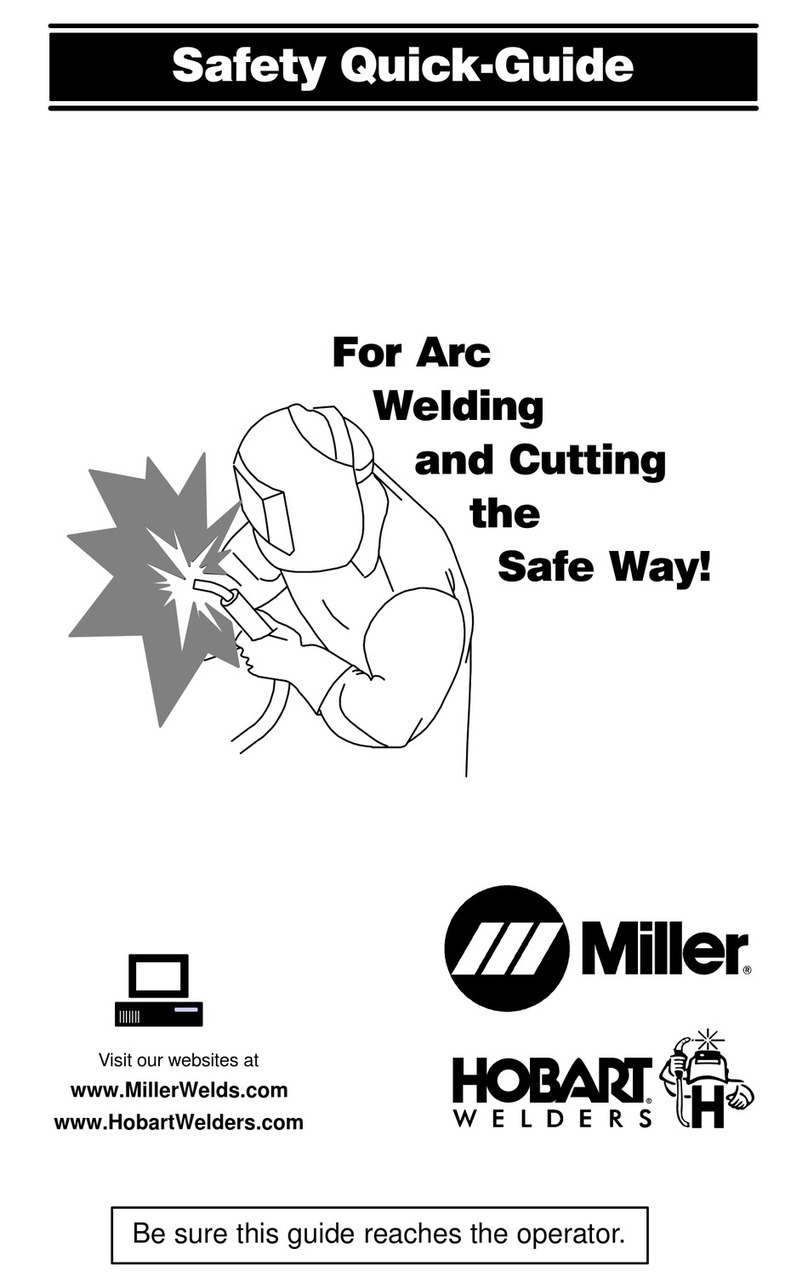SifWeld TSX1D300MTS User manual

Operation Manual
SifWeld MTS300/400
www.sifweld.com
Peters House
The Orbital Centre
Icknield Way
Letchworth Garden City
Hertfordshire
SG6 1ET
Tel. +44 (0) 845 130 7757
TSX1D300MTS
TSX3D400MTS
MIG
Approved
TIG MMA

DECLARATION OF CONFORMITY
The Low voltage Directive 2006/95/EC of 12 December 2006, entering into force 16 January 2007
The EMC Directive 2004/108/EC, entering into force 20 July 2007
The RoSH Directive 2011/65/EC, entering into force 2 January 2013
Type of Equipment
Welding power source for MIG/MAG, TIG/TAG, MMA welding
Brand name or trade mark
SifWeld®
Type designation etc.
MTS300/400
Manufacturer or his authorised representative established within the EEA
Name, address, telephone no, fax no
Weldability Sif
Peters House, The Orbital Centre
Icknield Way, Letchworth
Hertfordshire, SG6 1ET
United Kindom
Phone: +44 (0)845 130 7757 Fax: +44 (0)800 970 7757
The following harmonised standard in force with the EEA has been used in the design:
EN60974-1- Arc welding equipment- Part 1: Welding power sources
EN60974-10 Arc welding equipment - Part 10: Electromagnetic Compatibility (EMC) requirements
Additional information: restrictive use, Class A equipment, intended for use in locations other than residential
By signing this document, the undersigned declares as manufacturer, or the manufacturer’s authorised
representative established within the EEA, that the equipment in question complies with the safety
requirements stated above.
WEEE Directive & Product Disposal
At the end of its serviceable life, this product should not be treated as household
or general waste. It should be handed over to the applicable collection point for
the recycling of electrical and electronic equipment, or returned to the supplier for
disposal.
Place and Date
Letchworth, UK
01-04-2015
Position
Quality Manager
Weldability Sif
Signiture
Keith Mullan

Safety Guidelines
These general safety norms cover both arc welding machines and plasma cutting machines unless
otherwise noted. The equipment must only be used for the purpose it was designed for. Using it in any
other way could result in damage or injury and in breach of the safety rules. Only suitably trained and
competent persons should use the equipment. Operators should respect the safety of other persons.
Prevention against electric shock
The equipment should be installed by a qualified person and in accordance with current standards in
operation. It is the user’s responsibility to ensure that the equipment is connected to a suitable power
supply. Consult with your utility supplier if required. If earth grounding of the work piece is required,
ground it directly with a separate cable. Do not use the equipment with the covers removed. Do not
touch live electrical parts or parts which are electrically charged. Turn off all equipment when not in use.
Cables (both primary supply and welding) should be regularly checked for damage and overheating.
Do not use worn, damaged, under sized or poorly jointed cables. Ensure that you wear the correct
protective clothing, gloves, head and eye protection. Insulate yourself from work and ground using
dry insulating mats or covers big enough to prevent any physical contact with the work ground. Never
touch the electrode if you are in contact with the work ground, or another electrode from a different
machine.
Do not wrap cables over your body. Ensure that you take additional safety precautions when you are
welding in electrically hazardous conditions such as damp environments, wearing wet clothing, and
metal structures. Try to avoid welding in cramped or restricted positions. Ensure that the equipment
is well maintained. Repair or replace damaged or defective parts immediately. Carry out any regular
maintenance in accordance with the manufacturer’s instructions.
Safety against fumes and welding gases
Locate the equipment in a well-ventilated position. Keep your head out of the fumes. Do not breathe
the fumes. Ensure the welding zone is in a well-ventilated area. If this is not possible provision should
be made for suitable fume extraction. If ventilation is poor, wear an approved respirator. Read and
understand the Material Safety Data Sheets (MSDS’s) and the manufacturer’s instructions for metals,
consumable, coatings, cleaners, and de-greasers. Do not weld in locations near any de-greasing,
cleaning, or spraying operations. Be aware that heat and rays of the arc can react with vapours to form
highly toxic and irritating gases. Do not weld on coated metals, unless the coating is removed from the
weld area, the area is well ventilated, and while wearing an air-supplied respirator. The coatings on many
metals can give off toxic fumes if welded.
Prevention against burns and radiation
Arc rays from the welding process produce intense, visible and invisible (ultraviolet and infrared) rays
that can burn eyes and skin. Wear an approved welding helmet fitted with a proper shade of filter lens
to protect your face and eyes when welding or watching. Wear approved safety glasses with side shields
under your helmet. Never use broken or faulty welding helmets. Always ensure there are adequate
protective screens or barriers to protect others from flash, glare and sparks from the welding area. Ensure
that there are adequate warnings that welding or cutting is taking place.
3

Wear suitable protective flame resistant clothing. The sparks and spatter from welding, hot work pieces,
and hot equipment can cause fires and burns. Welding on closed containers, such as tanks, drums, or
pipes, can cause them to explode. Accidental contact of electrode to metal objects can cause arcs,
explosion, overheating, or fire. Check and be sure the area is safe and clear of inflammable material
before carrying out any welding.
Protection against noise
Some welding and cutting operations may produce noise. Wear safety ear protection to protect your
hearing.
Protection from moving parts
When the machine is in operation, keep away from moving parts such as motors and fans. Moving
parts, such as the fan, may cut fingers and hands and snag garments. Protections and coverings may
be removed for maintenance and controls only by qualified personnel, after first disconnecting the
power supply cable. Replace the coverings and protections and close all doors when the intervention
is finished, and before starting the equipment. Take care to avoid getting fingers trapped when loading
and feeding wire during set up and operation. When feeding wire be careful to avoid pointing it at other
people or toward your body. Always ensure machine covers and protective devices are in operation.
Precautions against fire and explosion
Avoid causing fires due to sparks and hot waste or molten metal. Ensure that appropriate fire safety
devices are available near the cutting / welding area. Remove all flammable and combustible materials
from the cutting / welding zone and surrounding areas. Do not cut/weld fuel and lubricant containers,
even if empty. These must be carefully cleaned before they can be cut/welded. Always allow the cut/
welded material to cool before touching it or placing it in contact with combustible or flammable
material. Do not work in atmospheres with high concentrations of combustible fumes, flammable gases
and dust. Always check the work area half an hour after cutting to make sure that no fires have begun
Risks due to magnetic fields
The magnetic fields created by high currents may affect the operation of pacemakers or electronically
controlled medical equipment. Wearers of vital electronic equipment should consult their physician
before beginning any arc welding, cutting, gouging or spot welding operations. Do not go near welding
equipment with any sensitive electronic equipment as the magnetic fields may cause damage.
RF Declaration
Equipment that complies with directive 2004/108/EC concerning electromagnetic compatibility (EMC)
and the technical requirements of EN60974-10 is designed for use in industrial buildings and not those
for domestic use where electricity is provided via the low voltage public distribution system. Difficulties
may arise in assuring class A electromagnetic compatibility for systems installed in domestic locations
due to conducted and radiated emissions. In the case of electromagnetic problems, it is the
responsibility of the user to resolve the situation. It may be necessary to shield the equipment and fit
suitable filters on the mains supply.
4

5
LF Declaration
Consult the data plate on the equipment for the power supply requirements. Due to the elevated
absorbency of the primary current from the power supply network, high power systems affect the
quality of power provided by the network. Consequently, connection restrictions or maximum
impedance requirements permitted by the network at the public network connection point must be
applied to these systems. In this case the installer or the user is responsible for ensuring the equipment
can be connected, consulting the electricity provider if necessary.
Materials and their disposal
The equipment is manufactured with materials, which do not contain any toxic or poisonous
materials dangerous to the operator. When the equipment is scrapped, it should be dismantled
separating components according to the type of materials. Do not dispose of the equipment with
normal waste. The European Directive 2002/96/EC on Waste Electrical and Electronic Equipment states
the electrical equipment that has reached its end of life must be collected separately and returned to an
environmentally compatible recycling facility.
Handling of Compressed gas cylinders and regulators
All cylinders and pressure regulators used in welding operations should be handled with care.
Never allow the electrode, electrode holder or any other electrically “hot” parts to touch a cylinder.
Keep your head and face away from the cylinder valve outlet when opening the cylinder valve.
Always secure the cylinder safely. Never deface or alter any cylinder.
The following signs and explanations are to remind the user of the potential
risks involved and the dangers of misuse or mistreatment of the welding
machine.
!
RUNNING PARTS MAY BE DANGEROUS!
Keep away from running components,
including the fan.
BE AWARE OF SPARKS AND SPATTER
Wear protective clothing, such as leather
gloves, Flame retardant overalls, boots and
eyewear.
DO NOT TOUCH THERMAL COMPONENTS!
Thermal components may cause severe burns
when in contact with unprotected skin.
ELECTRIC SHOCKS CAN KILL!
Never touch electrical parts. Keep the
equipment in good condition, replace
damaged parts, undertake regular
maintenance according to the instructions.

1. Preface 7
1.1 General 7
1.2 Introduction 8
1.3 Technical Specications 9
1.4 Overview Of Machine 10
2. Installation 11
3. Operation 14
4. Troubleshooting 16
5. Maintenance 17
6. Warranty 18
Contents
6

7
1. Preface
Congratulations on choosing your SifWeld welding machine.
Used correctly, SifWeld products can signicantly increase the productivity of your welding, and provide
years of economical service. This operating manual contains important information on the use,
maintenance and safety of your SifWeld product. Please read the manual carefully before using the
equipment for the rst time. For your own safety and that of your working environment, pay particular
attention to the safety instructions in the manual.
For more information on SifWeld products, contact an authorised SifWeld dealer, or visit the SifWeld web
site at www.sifweld.com. The specications presented in this manual are subject to change without prior
notice.
Important notes
Items in the manual that require particular attention in order to minimise damage and personal harm
are indicated with the ’NOTE!’ notation. Read these sections carefully and follow the instructions.
Disclaimer
While every effort has been made to ensure that the information contained in this guide is accurate and
complete, no liability can be accepted for any errors or omissions. We reserve the right to change the
specication of the product described at any time without prior notice. Do not copy, record, reproduce
or transmit the contents of this guide without prior permission.
1.1 General

The SifWeld MTS300 and 400 machines are multi-process CC/CV power sources designed for
demanding professional use in Steel, Stainless, Cast Iron, Bronze, Aluminium and Copper welding. The
power source has a control panel that allows ready control of the functions of the welding functions.
The SifWeld MTS300 and 400 are inverter-based welding machines with a separate wire feed unit with
added MMA and TIG functions. These are industrial machine equipped with a separate 4-roll-gear-driven
wire feed system and 5metre interconnecting cables. The MIG function allows you to weld with Solid
wires, Flux-cored Gas and Gasless wires. Adjustment of Voltage & Wire Feed at the wire feeder make for
easy setting of welding parameters and give the convenience of remote adjustment from the power
source. The Crater Current setting delivers perfect nishing of the weld, the electronic inductance offers
ne adjustment of the arc characteristic and burn back adjustment leaves the wire stick out ready for the
next weld.
Wire inch and Gas Check provides set up of the wire feed and gas setting with reduced wastage of
wire or gas. Added MMA welding capability delivers easy and high quality welding using electrodes,
including cast Iron, stainless and low hydrogen. Connection of the 17V or 26V TIG torch provides quality
DC TIG (scratch start) welding of steel, stainless steel and copper. Ideal for heavy and structural welding
applications through to general fabricators, maintenance workshops, light engineering, rural, agriculture
and domestic workshops.
Features
• Innovative IGBT Inverter Technology
• MIG/MAG with Gas and Gasless wire function
• Stick Electrode (MMA) Function
• DC TIG Welding With Scratch Start
• Voltage & Wire Feed Controls at Wire Feeder
• Variable Inductance & Burn Back Controls
• Adjustable Crater Current Control
• Gas Check / Inch Wire
• 2T/4T Trigger Function
• Separate 4 Roll Geared Wire Feeder
• LED Digital Displays
• Euro MIG torch connection
• 5/10/15 m Interconnecting Cables
• Excellent arc stability for MIG/TIG/MMA welding
1.2 Introduction
8

9
1.3 Technical Specications
SifWeld MTS400SifWeld MTS300
Power voltage (V) 1 ph 230/240v 3 ph 380/415v
Rated duty cycle
Rated power MIG
I Max MIG
I Max MMA
I eff MIG
I eff MMA
Wire feed type
Protection class
Insulation class
Dimensions (Power source) mm
Weight (Power source) kg
Dimensions (Air cooled package) mm
Weight (Air cooled package) kg
Dimensions (Water cooled package) mm
Weight (Water cooled package) kg
300Amps @ 35% 400Amps @ 100%
-
12.8 KVA 18.2 KVA
45.0Amps
51.0Amps
26.6Amps
34.0Amps
35.0Amps
26.0Amps
28.0Amps 27.0Amps
Gear Driven 4 Roll Gear Driven 4 Roll
IP21S IP21S
F F
550 x 290 x 680 550 x 290 x 680
33 43
1270 x 510 x 1110 1270 x 510 x 1110
90
-
-
100
1510 x 510 x 1110
120
175Amps @ 100%

1.4 Overview of Machine
Front View
Power Source Front Panel Layout
1. Mains Power LED
2. Thermal Overload LED
3. Over Current LED
4. V.R.D LED
5. 2T - 4T Trigger Switch
6. Voltage Meter
7. Gas Check Switch
8. Amperage Control (MMA/TIG)
9. Crater Current Control
10. Welding Cable Connection
11. MIG/MMA/TIG Mode Selector Switch
12. Amperage Meter
13. Inductance Control
14. Crater Voltage Control
15. Earth Cable Connection
Rear View
16. Burn Back Control
17. CO2 Heating Socket
18. Welding Cable Connection
19.Data Plate
20. Primary Input Cable
21. Primary Power Switch
22. Water Cooler Power Socket
23. Control Cable Connection
16
17
18
19
20
21
22
23
10
12 3 4
5
6
7
8
9
10 15
14
13
12
11

11
2. Installation
Unpacking
Check the packaging for any signs of damage. Carefully remove the machine and retain the packaging
until the installation is complete.
Positioning of the machine
Place the machine on a rm, dry and level surface. Where possible, do not allow dust or other impurities
to enter the machines cooling air ow. Preferably site the machine above oor level; for example on a
suitable carriage unit.
Notes for positioning the machine
• The surface inclination should not exceed 15 degrees.
• Ensure the free circulation of the cooling air. There must be at least 20 cm of free space in front of
and behind the machine for cooling air to circulate.
• Protect the machine against heavy rain and direct sunshine.
NOTE! The machine should not be operated in the rain as the protection class of the machine, IP21S,
allows for outside transit and storage only.
NOTE! Never aim metallic grinding spray/sparks towards the equipment.
Input connection
Before connecting the machine you should ensure that the correct supply is available. Details of the
machine requirements can be found on the data plate of the machine or in the technical parameters
shown in the manual. The equipment should be connected by a suitably qualified competent person.
Always ensure the equipment has a proper grounding. Never connect the machine to the mains supply
with the panels removed.
Output connections
In general when using manual arc welding electrodes the electrode holder is connected to the positive
terminal and the work return to the negative terminal. Always consult the electrode manufacturer’s
data sheet if you have any doubts. When using the machine for TIG welding the TIG torch should be
connected to the negative terminal and the work return to the positive terminal.

MIG Welding
Insert the welding torch into the MIG torch Euro connector output socket on the front panel of the wire
feed unit, and tighten it. Install the wire spool on the spindle adapter of the wire feed unit.
Connect the cylinder equipped with the gas regulator to the gas inlet of the interconnection cable set.
Insert the cable plug with work clamp into the “-” output terminal on the front panel of the welding
machine, and tighten it clockwise.
Insert the quick plug of the interconnection cable set into the ‘+’ output terminal at the rear of the
welding machine, and tighten it clockwise. Connect the other end connection on the rear of the wire
feed unit. Insert the multi pin plug of the interconnection cable set into the control cable socket of the
welding machine and connect the other connection into the rear of the wire feed unit.
Ensure that the groove size in the feeding position on the drive roll matches the contact tip size of the
welding torch and the wire size being used. Release the pressure arm of the wire feeder to thread the
wire through the guide tube, and into the drive roll groove. Adjust the pressure arm, ensuring no sliding
of the wire. Too high pressure will lead to wire distortion, which will affect wire feeding. Press the wire
inch button to thread the wire out of the torch contact tip.
12

13
TIG Welding
Insert the cable plug with the work clamp
into the “+”socket on the front panel of the
welding machine, and tighten it clockwise.
Insert the cables plug of the TIG torch into
the “-”socket on the front panel of the
machine and tighten clockwise.
Connect the gas hose to the regulator / flow
meter located on the shield gas cylinder and
connect the other end to the machine. Open
the valve on the TIG torch and“scratch” the
electrode on the work piece to start the arc.
MMA welding
Insert the cable plug with electrode holder
into the “+” socket on the front panel of the
welding machine, and tighten it clockwise.
Insert the cable plug of the work return lead
into the “-” socket on the front panel of the
welding machine, and tighten it clockwise.

3. Operation
Before starting any welding activity ensure that you have suitable eye protection and protective
clothing. Also take the necessary steps to protect any persons within the area.
MMA
After connecting the welding leads as detailed you will need to switch the power switch on the back
panel to ‘ON’. Select MMA by switching to the MMA welding mode. There is voltage output at both
output terminals. Set the amperage on the machine suitable for the electrode being used. Ensure you
check that you have the electrode polarity correct. Please see below a guide to amperages required.
MIG/MAG
1) After installing the machine, and the power switch on the back panel is switched on, the machine is
ready to use. The ammeter displays the pre-set wire feed speed value, and the voltmeter displays the
pre-set voltage value. Open the cylinder valve, and switch the gas check switch to the“GAS CHECK”
position. Adjust the gas regulator to get the correct gas flow. After setting, switch the gas check switch
to the “Welding” position.
2) Get the correct arc conditions by adjusting the inductance control knob. Turn the knob anticlockwise
to get lower inductance and harder arc; turn it clockwise to get higher inductance and softer arc. Gener-
ally, select harder arc at lower current, while select softer arc at higher currents.
3) Select the correct welding current and welding voltage by adjusting the current control knob and
voltage control knob on the wire feeder.
4) Select 2T or 4T operation mode. In 2T mode, arc is ignited by pushing the torch trigger, and arc stops
by releasing the torch trigger. In 4T mode, welding can be continued when releasing the torch trigger
after arc is ignited, and at this time, welding instructions should be set by adjusting the current control
knob and voltage control knob on the wire feeder. When pushing the torch trigger again, the machine
enters into crater welding, and at this time. Crate parameters should be set by adjusting the crater/weld-
ing current control knob and crater voltage control knob on the front panel of the machine.
The actual current and voltage values are displayed on the front panel of the machine. When the torch
trigger is released, welding ends. 2 seconds after welding ends, the gas supply will be cut off.
1.0 20-60 3.2 108-148
Electrode Diameter (mm) Welding Current (A) Electrode Diameter (mm) Welding Current (A)
1.6 40-84 4.0 140-180
2.0 60-100 5.0 180-220
2.5 80-120 6.0 220-260
14

15
Gas selection
Metal inert gas welding (MIG): Uses Argon (Ar), Helium (He) or Ar-He mixtures as the shield gas, and
is mainly used for welding aluminium and its alloys. Metal active gas welding (MAG): Uses Argon (Ar)
mixed with a certain amount of CO2 / O2 as the shield gas, and is usually used on steels in short circuit
transfer and spray transfer. It can be applicable to flat position welding, vertical position welding,
overhead position welding and all-position welding, and it mainly used for welding carbon steel, high
strength low alloy steel and stainless steel. Welding robots mostly use the MAG process. CO2 (carbon
dioxide) gas shielded arc welding (CO2 welding): It uses CO2 as the shield gas, and is usually used in
globular transfer and short circuit transfer to implement welding. It can be used to weld in different
positions. As compared with other welding methods, CO2 welding is popular and low cost, though it
produces more spatter, CO2 welding is widely used for general metal structure welding.
1) Welding current setting
Set the welding current after the above preparation. Short circuiting transfer is mainly fit for electrode
wires of diameter 0.6~1.2mm. As a guide for short circuit welding set the welding current according to
the table below.
2) Welding speed selection
The welding quality and productivity should be taken into consideration for the selection of wire feed
speed. In the case that the welding speed increases, it weakens the protection effect and quickens the
cooling. As a consequence, it is not good for weld bead shaping. In the event that the speed is too slow,
the work-piece will be burned through, and a good weld bead will be unavailable. In practical operation,
the wire feed speed should not exceed 50cm/min.
3) Wire Stick-out
The increase of the stick-out can improve the productivity, but too long stick-out may lead to excessive
spatter, wire breaking and unstable welding. Generally, the stick-out should be 10 times the welding
wire diameter.
4) Shield gas flow selection
The protection effect is the primary consideration. Besides, the protection effect of inner-angle welding
is better than that of external-angle welding, so the gas flow in inner-angle welding should be lower.
Less or no shield gas is needed in FCAW. Refer to the table below for the recommended gas flow rates.
0.8 50-120 70-100
Wire Diameter (mm) Welding Current Range (A) Optimal Current (A)
1.0 70-180 80-120
1.2 80-350 100-200
Gas Flow (L/m) 5-15 15-20 20-25
Welding Mode Welding with thin wire Welding with thick wire Welding with thick wire
under high current

4. Troubleshooting
In the event of a failure of the machine, contact an authorised SifWeld service centre. The following
operation requires sufficient professional knowledge on electric aspects and comprehensive safety
knowledge. Make sure the input cable of the machine is disconnected from the electricity supply and
wait for 5 minutes before removing the machine covers. Before taking your unit for servicing, check the
list below.
SolutionCauseSymptom
The welding current is unstable.
There is output current when
pushing the torch trigger to feed
gas, but the wire feeder does not
work.
When the torch trigger is pushed,
there is gas output and the wire
feeder works, but there is no
output current, and the
protection LED is off.
No response when pushing the
torch trigger and the protection
LED is off.
There is no-load voltage.
Other malfunction.
The pressure arm on the wire feeder
is not properly adjusted.
The control cable of the wire feeder
is broken.
The earth cable is not well
connected with the wire feeder.
The welding torch is not well
connected with the wire feeder.
The mains voltage is too low.
The drive roll does not match the
wire size being used.
The wire feeder is clogged.
The wire feeder cable is not well
connected.
The control cable of the wire feeder
is not well connected with power
supply.
The contact tip of the welding torch
is badly worn.
The wire feeder fails.
The wire feeder or welding torch fails.
The torch trigger fails.
The wire feeding tube of the welding
torch is badly worn.
The control PCB or wire-feeder
power PCB inside the machine fails.
The welding wire is of poor quality.
Adjust it to get proper pressure.
Get it repaired or replaced.
Reconnect the earth cable.
Reconnect the welding torch.
Welding can be carried out after the
mains voltage recovers.
Contact your local service centre.
Make sure they match with each
other.
Un-clog the wire feeder.
Reconnect the wire feeder cable.
Reconnect the control cable.
Replace it.
Replace the wire feeder.
Replace the wire feeder and/or torch.
Replace the welding torch.
Replace it.
Replace it.
Replace with high quality wire.
16

17
5. Maintenance
The utilisation level of the power source and its working environment should be taken into
consideration in planning the frequency of maintenance of the machine. Appropriate use and
preventive maintenance guarantee the best trouble-free use of the equipment. This allows you to avoid
interruptions in use and increases the productivity of the machine.
5.1 Cables
Check the condition of welding and mains cables daily. Do not use damaged cables. Also make sure that
all extension cables used in the mains connection are in proper condition and compliant with
regulations.
NOTE! The mains cables should be repaired and installed only by electrical contractors and
installers trained and authorised to perform such operations.
5.2 Power source
Before cleaning the interior of the machine, you need to remove the case by unscrewing the mounting
screws at the top and sides of the machine.
NOTE! To prevent damage, wait approximately ve minutes after disconnecting the mains cable
before removing the machine’s case. Perform the following cleaning and maintenance at least
every six months:
1. Clean the interior of the machine and the fan grills net of any dust and grime stains – for
example, with a soft brush and vacuum cleaner.
• Do not use pressurised air. The contaminant may become compressed into the grooves of the
coolers.
• Do not use a pressure-washing device.
2. Check the electrical connections of the machine. Clean any oxidised connections, and tighten the
loosened ones.
• Check for the right tension before you start repairing the connections.
NOTE! Remember that the machine may be repaired only by an electrical contractor or installer
trained and authorised to perform such operations.
5.3 Regular maintenance
Authorised SifWeld service centres can perform regular preventative maintenance by agreement. Tasks
included in regular maintenance:
• Cleaning of equipment.
• Inspection and maintenance of the welding gun.
• Checking of connectors, switches, and control knobs.
• Checking of electrical connections.
• Checking of the mains cable and plug.
• Replacement of damaged or worn parts.
• Testing and adjustment of the functions and operational values of the machine, if necessary.

6. Warranty
18
Weldability Sif warrants its customers that all new SifWeld manual welding and cutting equipment purchased shall be free of failure
from defective materials or production for a period of 2 Years from the date of purchase.
This warranty period can be extended to 5 Years from the date of purchase (including the standard warranty period) for customers
in the United Kingdom and Republic Of Ireland; or to 3 Years from date of purchase for customers in all other countries, subject to
registration of the product at www.sifweld.com within the rst year of purchase, and undergoing annual preventative maintenance
servicing with effect from the second year of ownership.
All warranty periods start from the date of purchase from Weldability Sif or an approved SifWeld distributor to the original end user.
The date on the sales invoice is considered the date of purchase for the purpose of the warranty period, or the date of manufacture is
used if proof of purchase is not available. Equipment is warranted to the original owner/user customer, and is not transferable.
Subject to the underlying purchase contract, or, failing such, the Weldability Sif general terms and conditions of sale, both the cost of
replacement parts and Weldability Sif’s labour expense in correcting defects covered by the warranty, will be assumed by Weldability
Sif during the warranty period. Weldability Sif shall in no event be responsible for any direct or indirect damages, third party
expenses, as well as any loss of income/revenue, all of which are specically excluded under this warranty.
The warranty does not cover : Any defects resulting from normal wear and tear; Improper use; Failure to observe the operating
and maintenance instructions; Connection to an incorrect or faulty mains supply; Overloading during use; Any transport or storage
damage; External damage such as re, impact or damage due to natural causes, e.g ooding; Use of unapproved spare or wear parts
or replacement parts not supplied by or approved by Weldability Sif; Any modication or alteration of the equipment; or any other
circumstances beyond the control of Weldability Sif. The warranty period is based on a single 8-hour 5-day shift pattern and the
extended warranty is not applicable to units that are purchased for rental or hire. Weldability Sif will submit an invoice for any repair
work performed outside the scope of the warranty.
Any warranty repair must be performed by Weldability Sif or an Authorised SifWeld Service Centre. The customer is responsible for
all shipping costs and risk associated with items that are returned covered under warranty. Weldability Sif may opt to refund the
purchase price (less any costs and depreciation due to use and wear). Faults/defects found under warranty should be reported to
the Weldability Sif Technical team for review. A warranty claim reference number will be issued and details of the most appropriate
Authorised SifWeld Service Centre will be advised, if appropriate. The customer has no claim to any loan or replacement products
whilst repairs are being performed or replacements are being provided.
The decision about repair or replacement of any defective part(s) is made by Weldability Sif. The replaced part(s) remain(s) property of
Weldability Sif. The warranty extends only to the machine power-source, wire-feed unit and parts contained inside. No other warranty
is expressed or implied, including with regard to the tness of the equipment for any particular application.
Under the terms of the warranty, welding torches, their consumable parts, wire-feed drive-rolls and guide tubes, work return cables
and clamps, electrode holders, connection and extension cables, mains and control leads, plugs, wheels, coolant, etc. are not covered.
The extended warranty is only valid where products have been used strictly in accordance with the operating instructions, all
installation guidelines have been implemented, all legal requirements have been observed, regular preventative maintenance has
been undertaken and a continuous history of annual servicing has been completed and recorded. Failure to register the equipment
online within 1 year of purchase, or to complete the required annual servicing cycle from year 2, will invalidate the extended warranty
period.
Annual preventative maintenance servicing must be arranged and paid-for by the equipment owner/user and carried out by
Weldability Sif or an Authorised SifWeld Service Centre, in order to maintain validity of the extended warranty. Service visits can
be booked online at www.sifweld.com or by calling 0870 330 7757 and will be charged at an average of £65 net per hour of travel/
servicing time. Please allow an average of 2 hours servicing per machine and one hour each way of travel.
Warranty support is facilitated by our network of Authorised SifWeld Service Centres that provide highly experienced capability and
carry-out the professional repair, service and calibration of SifWeld equipment.

Notes

www.sifweld.com
®
Peters House, The Orbital Centre, Icknield Way, Letchworth Garden City, Hertfordshire, SG6 1ET
Tel. +44 (0) 845 130 7757 | Fax. +44 (0) 800 970 7757 | Email. sales@weldability-sif.com | www.sifweld.com
This manual suits for next models
1
Table of contents
Other SifWeld Welding System manuals

SifWeld
SifWeld MTS 200 User manual
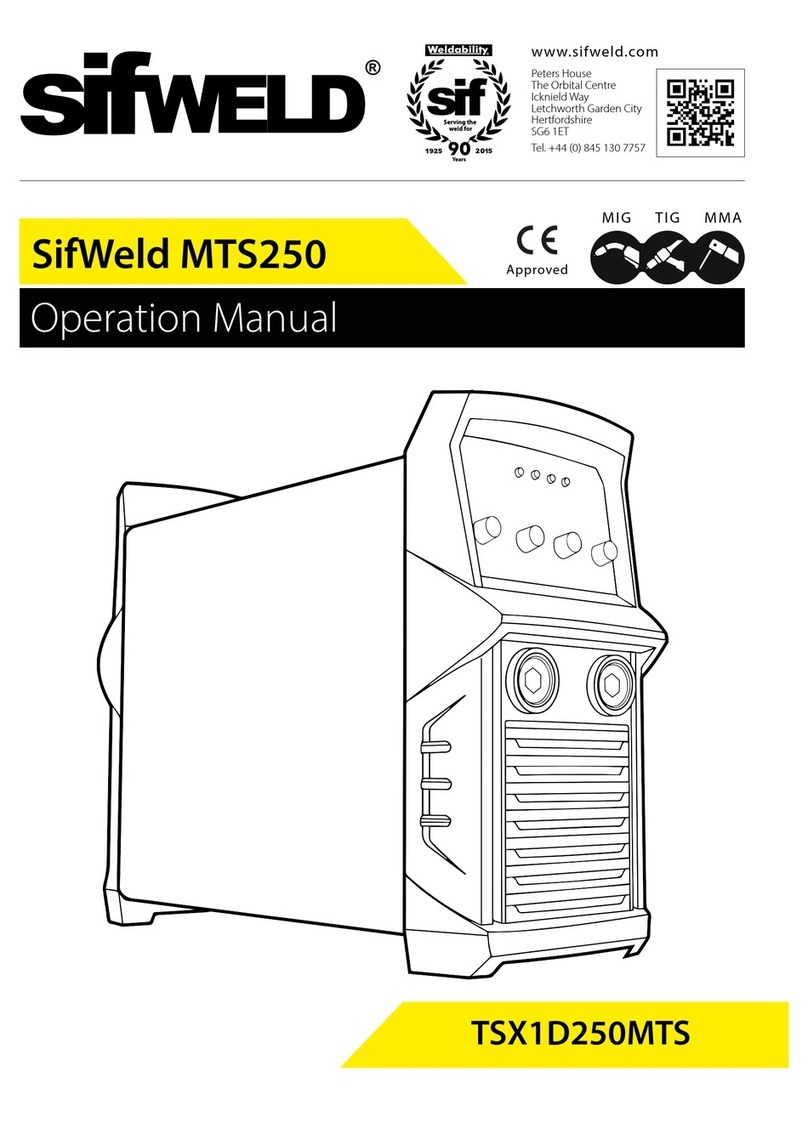
SifWeld
SifWeld MTS250 TSX1D250MTS User manual
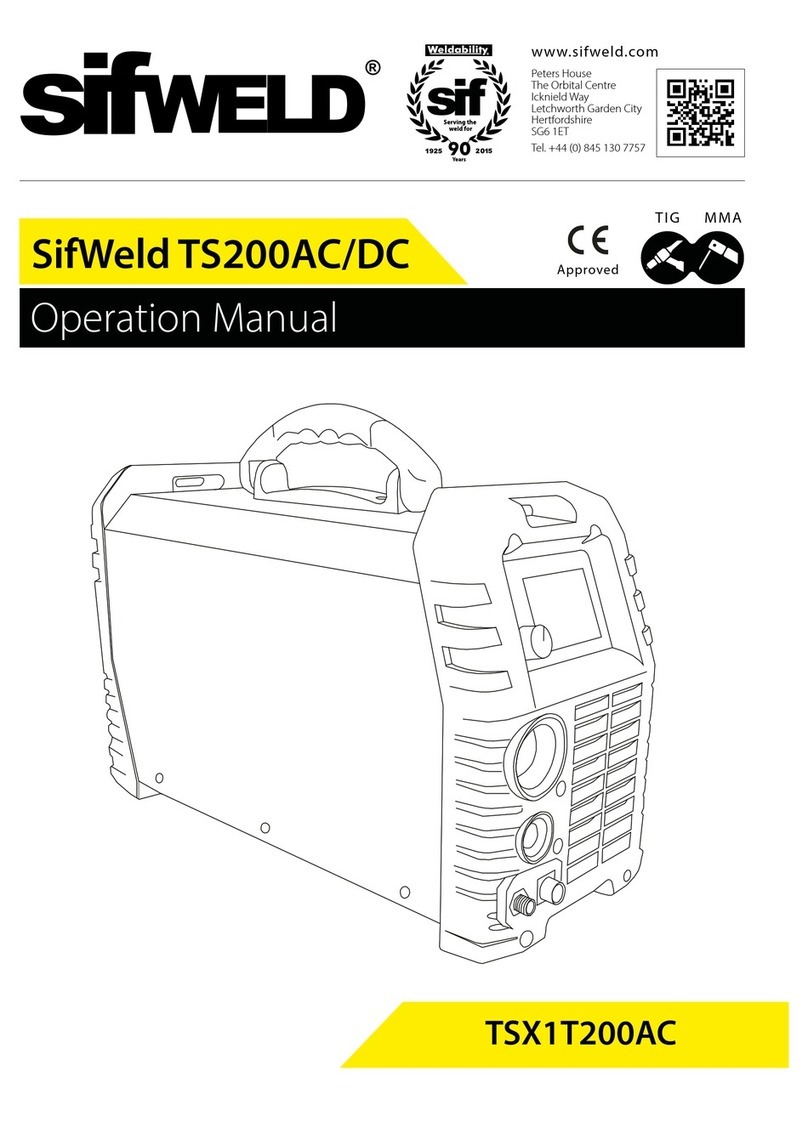
SifWeld
SifWeld TS200AC/DC TSX1T200AC User manual
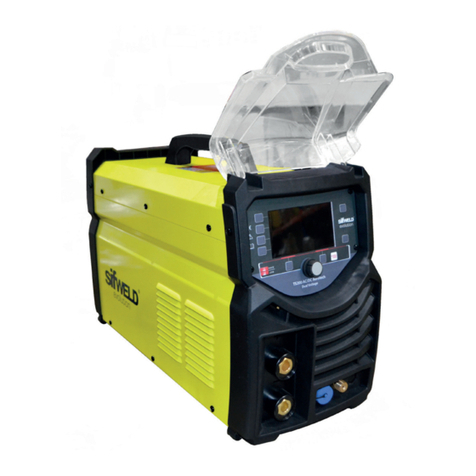
SifWeld
SifWeld Evolution Aerotech TS200ACDC User manual

SifWeld
SifWeld Evolution MTS500 ROBOT User manual

SifWeld
SifWeld Evolution CUT40 Air User manual
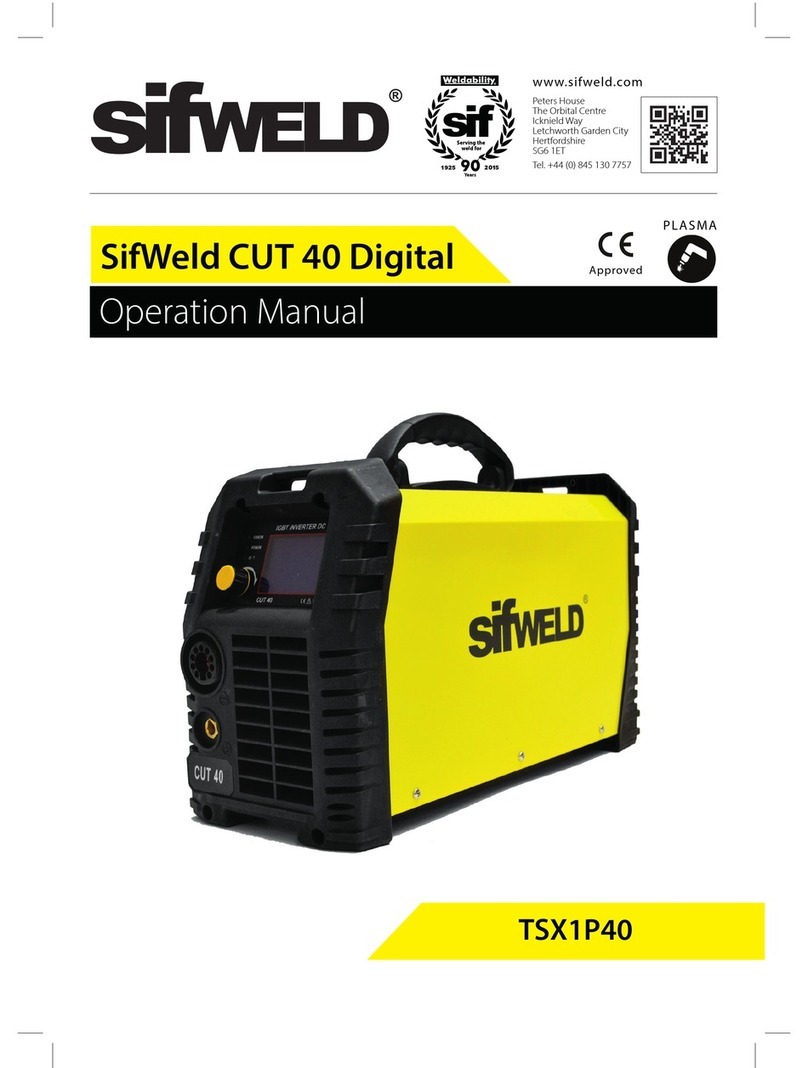
SifWeld
SifWeld CUT 40 Digital User manual
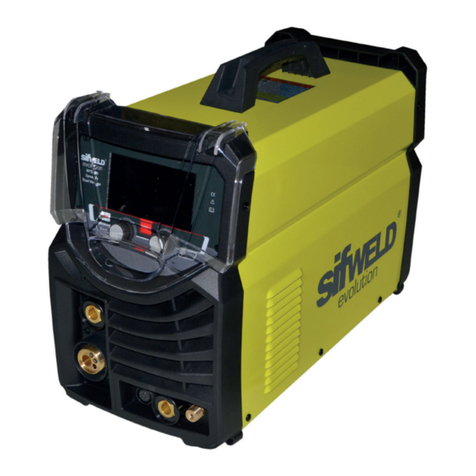
SifWeld
SifWeld Evolution MTS200 SYN User manual
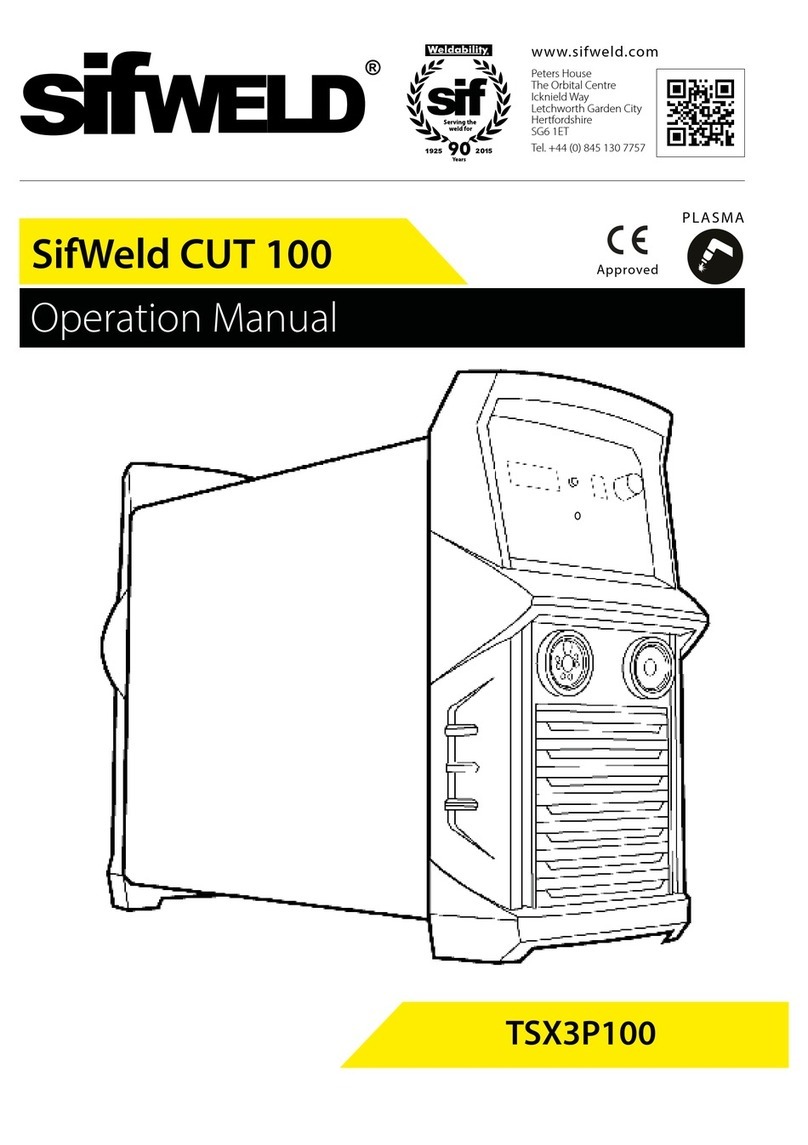
SifWeld
SifWeld CUT 100 Installation manual
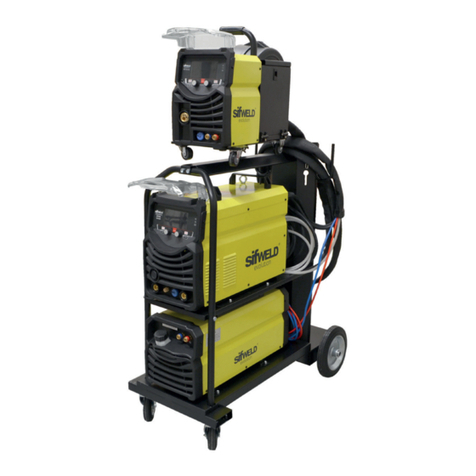
SifWeld
SifWeld Evolution MTS400 SYN User manual
